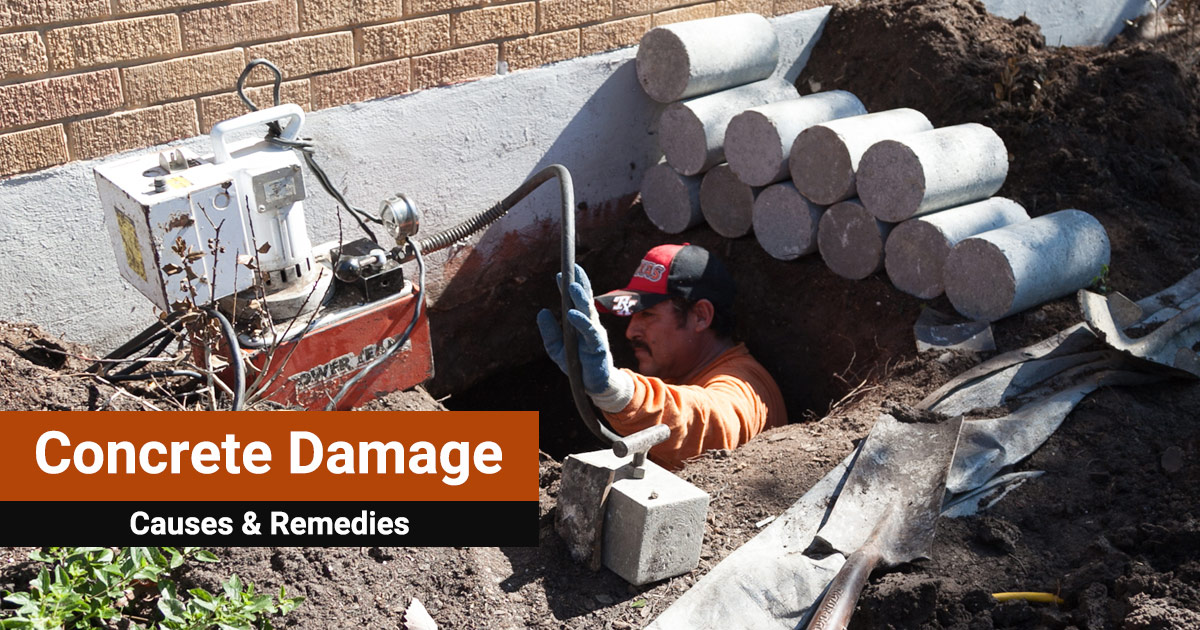512.291.0709
Mon - Fri: 9 AM - 11:30 AM
12:30 PM - 4 PM
August 2, 2023

The toughness of concrete makes it the go-to material for foundation construction and reinforcement. However, it’s not immune to damage, especially here in Austin, where the soil and weather conditions can cause quite a bit of strain. This article explores the common causes of concrete damage in local home foundations, and offers up the best solutions for prevention, mitigation, and repair.
Much of Austin is built on expansive clay soil, which is the primary culprit behind the region’s concrete damage. This type of soil expands and contracts as the moisture level changes, which typically follows seasonal shifts in rainfall and temperature. This shrink-swell cycle can wreak havoc on foundations and driveways, causing them to crack, tilt, or even collapse.
It’s safe to say that Austin’s weather can straddle both extremes. Unfortunately, these drastic differences can also contribute to concrete foundation damage.
The hottest, driest stretches of the year are sandwiched between periods with heavy rainfalls. This means that the soil first gets overloaded, expanding and exerting pressure on the foundation. Then it all dries out at a pace that the concrete just can’t adapt to. Gaps soon form between the soil and foundation, and become worse in periods of extended drought.
If you’ve found damaged sections of concrete in your home’s foundation, there are a number of options available. The right remedy will depend on the extent of the damage, the quality of your surrounding soil, and of course, your budget. You can learn more about the costs of foundation repair here.
Cracks are sealed back together, restoring the original strength and integrity of the foundation. Epoxy, a type of strong adhesive, is injected into the crack to bind it.
This method is relatively inexpensive and can be done quickly, but it won’t fix anything beyond minor structural damage, nor will it address the underlying causes. That being said, its minimal approach does make it the most affordable option for repairing cracks in the foundation, at just $250 to $800 per crack.
A grout mixture is pumped into the space under the slab to lift it back to its original position. Also known as "mudjacking," this method involves injecting a mixture of cement, soil, sand, and water beneath the slab to lift it back to its original position. The mixture is pumped under the slab through holes drilled into the concrete. Once the empty areas under the slab are filled, the concrete will level.
This method is less invasive and less expensive than others, but it may not be enough to resolve severe foundation problems. The cost of slab jacking can range from $2,000 to $5,000, depending on the size of the area and the amount of material required.
Often used to treat emergency foundation issues, foam injections rise quickly to fill gaps, lift the concrete, and stabilize the foundation. Foam is quick, effective, and less disruptive to the surrounding landscape than other solutions. However, it may not be suitable for all types of foundation problems, especially those related to structural integrity. It is only meant to be a temporary fix, until you can manage a full foundation repair or replacement.
This method can be more expensive than slab jacking due to the cost of the material. Pricing ranges from $2,500 to $6,000, depending on the size and complexity of the job.
Poured Concrete Piers: Concrete is poured into holes drilled into the ground, creating solid piers that support the foundation. Concrete piers are less expensive than other pier types, but not suitable for all situations, particularly if the soil conditions are poor. The soil beneath the home has to be capable of supporting the weight of the structure. Expect to pay anywhere from $300 to $800 per pier.
Steel Piers: Steel piers are highly recommended for permanent foundation repair solutions, especially in the face of severe foundation damage. These offer exceptional strength and support, able to be driven as deep as 100 feet. They are less likely to shift than concrete piers, but they are also more expensive. The cost can range from $1,000 to $3,000 per pier, with a typical home requiring 8 to 10 piers.
Helical Piers: Also known as screw piles, helical piers are screwed into the ground and used to lift and stabilize the foundation. They are attached to the foundation with brackets. This approach is less disruptive to the landscape than other methods and can be used in areas with limited access, making it favorable for homeowners who want to minimize both the extent of work and the stress put on their home’s structure. The cost of helical piers is similar to that of steel piers, ranging from $1,000 to $3,000 per pier.
Once your concrete foundation is back in decent shape, you can protect it against future degradation by stabilizing the soil beneath it. This process involves treatment with specific compounds that mitigate the shrink-swell cycle. It’s non-invasive, non-toxic, and offers a long-term solution for keeping your foundation supported. The average cost of soil stabilization is around $3,800, but can vary depending on the size of the area that needs to be treated.
Douglas Foundation Repair is one of Austin’s top contractors, helping homeowners throughout the region tackle even the most daunting repairs. Our expert team is capable of performing a wide range of repair types and treatments.
During your first appointment, you’ll be able to get a professional inspection and diagnosis of your concrete’s problems, and receive suggestions for solutions that can address the issue within your budget. Reach out to our crew today and request a visit to get the help you need.